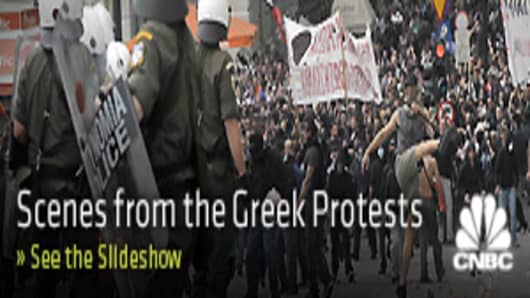Markets had a very volatile open yesterday morning with the Dow Jones Industrial Average jumping from up 25 points to down 25 points in rapid order.
After the third attempt to move up, the average moved steadily and deliberately lower.
At 2:25pm, the Dow was down 230 points and seemed to be building another down day in a recent series of down days.
With a riot in Greece being shown live on CNBC, weaker reports from retailers, and a market long overdue for a pull-back, the decline was not unexpected and felt orderly.
As I write at 7:30 edt, we still don’t know what led to the 750 point drop that occurred over the next 21 minutes reaching its nadir of 9872.57 at 2:46pm. Business reporters are suggesting “fat fingers” on a Citigroup keyboard as the explanation of supposedly misprinted trades. Procter and Gamble, Accenture, and Altria (Philip Morris) each had significantly lower, aberrational prints. These lower prints, we suppose, may have triggered computerized program selling.
As the market dropped our team was watching. A car wreck is a much too pleasant analogy. I was at my desk in 1987, 1989, 9/11, 2008, and I’ve never witnessed what I witnessed yesterday. Often significant drops or climbs involve a gap: a big price adjustment between trades. A stock may be trading at $25 when such overwhelming buy orders are entered that the next trade will be at $32, and prices will go higher from there.
There were no gaps yesterday. The decline was steady and relentless.
Panic hit Wall Street for 21 minutes yesterday, and we aren’t sure why. It’s disturbing to see that a “glitch” could cause a drop of this magnitude but reassuring that recovery followed and cool heads prevailed. The 21 minutes have served to camouflage a market that was down 230 points already. While we don’t see any need for panic, it strikes us that a pull-back after an 80% rise from the March 2009 lows is in order.
A pull-back would be normal.
Traders hate weekends because their capital commitments have to be left unadjusted until trading resumes on Monday. Traders will likely be more nervous about this weekend and will want to be “flat” (neither long nor short) before markets close. This could add to volatility today. Yesterday’s volatility was not surprisingly high. The plunge violated several technical support levels, but without understanding if the drop was in error, we can’t know how trustworthy the technical messages may be.


